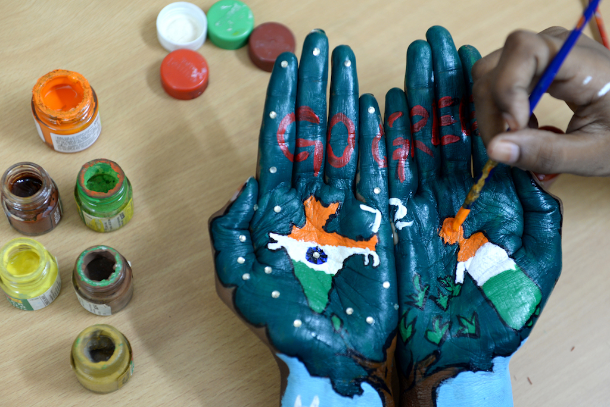As people celebrate across the country, questions remain about extreme poverty, inequality and religious discriminati

A student in Chennai gets her palms painted with India’s national flag colors and map ahead of Indian Independence Day celebrations. The day is celebrated every year across India on Aug. 15 to commemorate independence from Britain in 1947. (Photo by Arun Sankar/AFP)
As India celebrates another Independence Day on Aug. 15, many question if the political freedom it gained seven decades ago has helped to check violence, unemployment and discrimination against religious minorities.
The country continues to face challenges of extreme poverty, rising inequality, growing unemployment and rampant violence 71 years after the British declared India free on Aug. 15, 1947.
“It is shocking that several parts of the country are poorer than sub-Saharan Africa in the human development indicators and that one in every five Indians lives below the poverty line,” said Parbu Kumar, an educationist based in New Delhi.
He said government data show that despite economic growth and increased gross domestic product, the “plight of the poor has become frightening.”
About 43 percent of India’s 104 million tribal people and 29 percent of 200 million low-caste people are below the poverty line, meaning they cannot afford a full meal a day, according to government statistics.
Top of Form
Sign up to receive UCAN Daily Full Bulletin
Bottom of Form
Oxfam, a confederation of 20 independent charitable organizations focusing on poverty alleviation, reported this year that 73 percent of the wealth created in India in 2017 was cornered by the top 1 percent of the population.
Economic growth meant nothing to more than half of India’s 1.2 billion people, or 670 million, who saw their wealth rise by just 1 percent, the Oxfam report added.
“Successive governments since 1947 need to hold themselves accountable to the question of whether India is really a free place for marginalized people,” said Arun Mahar, a Mumbai-based Dalit activist.
The oppressive caste system that denied basic rights to lower castes was the biggest social challenge when India became independent, but the situation has not improved even after several sociopolitical campaigns and legal measures.
Mahar said the situation has worsened in the past four years since the pro-Hindu Bharatiya Janata Party (BJP) came to power as Hindu groups have taken the BJP’s political success as a mandate to impose upper-caste hegemony on Dalits and religious minorities.
“It has now become completely normal to persecute Dalit people,” Mahar said. Violence against Dalit women has been increasing. Government data show that 2,541 cases of rape and 3,172 cases of sexual harassment of Dalit women were reported in 2017.
“The government has admitted that rape of Dalit women has increased from past years. What has it done to make these ill-fated people feel secure to live in the country?” Mahar asked.
A.C. Michael, a Christian leader, told ucanews.com that the level of security enjoyed by religious minorities could be a yardstick of a country’s freedom. India has yet to make progress on that count, he said.
“It is a fact that we as a country have moved from nothing to something in the past seven decades. However, a lot needs to be done,” he said.
Michael said mob attacks on minorities are rampant and the government hasn’t done enough to address the trend.
“Land belonging to Christian tribals is being taken away by the government in Jharkhand and Chhattisgarh. Hindu mobs have several times attacked churches and desecrated places of worship. This needs to stop. Further, interference in religious matters by the majoritarian government must end without delay,” he added.
Michael underscored the need to punish those who have been persecuting minorities with impunity. “Instead of allowing lethal attacks from fringe Hindu groups, the government should take control and book culprits as per the law of the land,” he said.
Praveen Shukla, a rights activist in New Delhi, said India has yet to achieve complete freedom as the marginalized and minority groups continue to face persecution amid the government’s inaction.
Research by the Centre for the Study of Developing Societies this year revealed that more than 47 percent of Muslims across the country have said they feared being falsely accused of terrorist activities, he said.
The report, according to Shukla, also revealed that similar fears are on the rise among tribal and lower-caste people. Some 27 percent of tribal people fear being framed for anti-state Maoist activities, while 35 percent of Dalit people have a similar fear regarding petty thefts. “This is worrisome and merits immediate attention,” Shukla said.
Data journalism initiative IndiaSpend in its latest report claimed that “over the decade to 2016, the crime rate against Dalits rose by 25 percent from 16.3 crimes per 100,000 Dalits reported in 2006.”
For Imtiyaz Ahmad, an economist based in Jammu and Kashmir state, unemployment is a major challenge taking a toll on India’s youth.
Joblessness is projected to increase to 18.9 million by 2019, according to the International Labour Organization. India’s unemployment rate is expected to rise to 3.8 percent this year.
More than 50 percent of India’s population are aged under 25, while more than 65 percent are under 35. It is expected that in 2020 the average age of an Indian will be 29.
“We need to ask the government that if it wants us to celebrate the 71st Independence Day, what has it done to make the youth of the country independent in a real sense,” Ahmad said.
